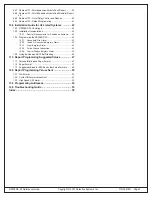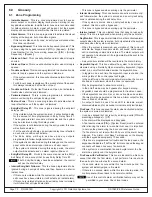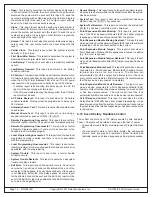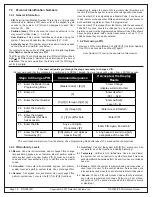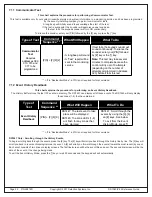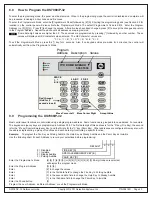
DS7080iP-32 Reference Guide Copyright © 2001 Detection Systems, Inc. P/N 39818D Page 9
5.0
System Overview
• Description: The DS7080iP-32 Control/Communicator is a fully
integrated hard-wire security and residential fire alarm system.
- It can support up to 8 input zones, two partitions, 24 individual
users, and multiple output options.
- Up to 4 keypads may be used to provide user interface with the
system, as well as programming access for the installer.
• Zone: A zone is an input to the DS7080iP-32 Control/
Communicator. There are 8 hard-wired zones on the main circuit
board.
• Zone 1: This zone can be programmed as a Fire or Burglar zone.
It is the only zone capable of supplying power to 2-wire smoke
detectors.
- When programmed as a Burglar zone, an alarm results on an
open or short when the control panel is armed.
- If trouble is programmed, a trouble report is generated, and the
zone is considered “Not Ready” only when the zone is disarmed.
- For Fire zone operation, see the Fire zone description in the
Glossary.
• Zones 2 - 32: These zones can be programmed as Fire or Burglar
zones.
- When programmed as a Burglar zone, an alarm results on an
open or short when the control panel is armed.
- If trouble is programmed, a trouble report is generated, and the
zone is considered “Not Ready” only when the zone is disarmed.
- For Fire zone operation, see the Fire zone description in the
Glossary.
• Cross-Zoning: Each on-board zone (zones 1-8) may be cross-
zoned with any or all of the other on-board zones. You cannot
cross-zone with the expansion module (EX8) zones.
When a pair of zones (A and B OR B and A) are cross-zoned, an
alarm condition is not generated unless:
1) Both A and B are in alarm simultaneously, or
2) B is in alarm within N seconds of the clearing of A or A is in
alarm within N seconds of the clearing of B, where N is the time
programmed in address 006. This allows for a one-way trip
pattern.
If two zones are cross-zoned to each other (A with B AND B with A)
an alarm condition is not only generated by conditions 1 and 2 above,
but also if:
3) A is in alarm within N seconds of the clearing of B. This allows
for a two-way trip pattern.
An alarm condition will be generated any time the above
criteria is met.
- Zone overlap required. Each zone shall have the ability to
individually protect the intended area (i.e. motion detector
patterns overlap).
- The following zone types
can be cross-zoned:
• Perimeter Instant (1)
• 24 Hour (2)
• Interior Home/Away (6)
• Interior Instant (7)
• Day Monitor (8)
• Interior Delay (D)
• Perimeter Homeguard (E)
- The following zone types
cannot be cross-zoned:
• Disabled (0)
• Entry/Exit Delay #1 (3)
• Entry/Exit Delay #2 (4)
• Interior Entry/Exit Follower (5)
• Keyswitch Toggle (9)
• Keyswitch On/Off(A)
• Fire Zone with Verification (B)
• Fire Zone without verification (C)
• Perimeter Follower Homeguard (F)
4) Cross-zoning across partitions is not supported.
5) Cross-zoning with different zone types is not supported.
6) If the trip window is 000, the cross-zone time will be the duration
of the arm cycle of the crossed non-24 hour zones. 24 hour zones
will have a 24 hour duration.
• Trouble Zone (TRBL): This non-supervised (requires no End Of
Line resistor) zone is intended for the use of simple tamper devices.
If tripped, this zone will generate a Control Trouble/System Fault.
This trouble will clear when the Trouble Zone loop is un-faulted.
- Trouble Zone is disabled by default.
- Trouble Zone has two modes of operation: Normally Open and
Normally Closed.
• EX8 Expansion Module: Up to three (3) EX8 Expansion Modules
(24 additional zones) may be added to the system. They must be
set for Option Bus Addresses 101, 102 and 103 respectively (see
the EX8 Installation Guide P/N 39565 for module addresses). It is
important that each module be set with a different address. Failure
to do so will result in improper communications with the EX8
modules and the zones associated with them.
• DS7488 Octal Relay: If installed, the optional DS7488 Octal Relay
will provide fixed outputs for predetermined panel conditions. The
DS7488 Octal Relay attaches to the keypad bus and must be set
for Option Bus Address 9.
Octal relay outputs will not operate during the first two
minutes after powering up the control panel.
The fixed outputs are:
- Output 1 - Zone Alarm: Follows any zone alarm (except Silent
and Invisible zones). Remains On until the zone restores, the
bell cutoff time expires or [PIN] + [Off] is entered.
- Output 2 - Zone Trouble: Follows any zone trouble. Latches
ON when any zone is in an abnormal condition.
- Output 3 - System Reset: Activates for 8 seconds when the
[PIN] + [System Reset] command is entered at any keypad.
- Output 4 - Panic/Duress: Latches ON when the Panic (C) key
is pressed for 2 seconds on any keypad or when a Duress
Code is entered into any keypad. The relay is released when
the command [PIN] + [Off] is entered at any keypad.
- Output 5 - System Trouble: This relay is ON when a system
trouble has occurred. Releases when the system trouble is
cleared.
- Output 6 - Low Battery: The relay is ON during a Low Battery
condition.
- Output 7 - Partial Arm: In a non-partitioned system the relay
is ON when the system is partially armed (Force Arm, Perimeter
Arm or zones bypassed). In a partitioned system, the relay is
ON when any partition is partially armed. The relay is reset
when the system (or partition) is disarmed or is fully armed.
- Output 8 - Armed: In a non-partitioned system the relay is ON
when the system is armed to any level. In a partitioned system,
the relay is ON when both partitions are armed to any level.
The relay is reset when the system or any partition is disarmed.



